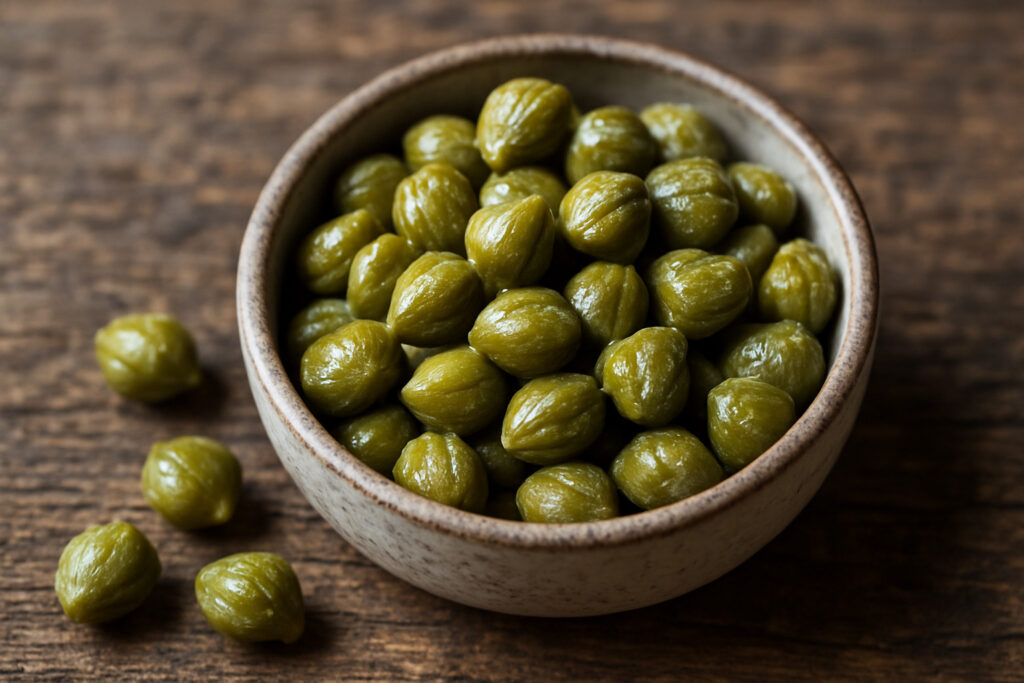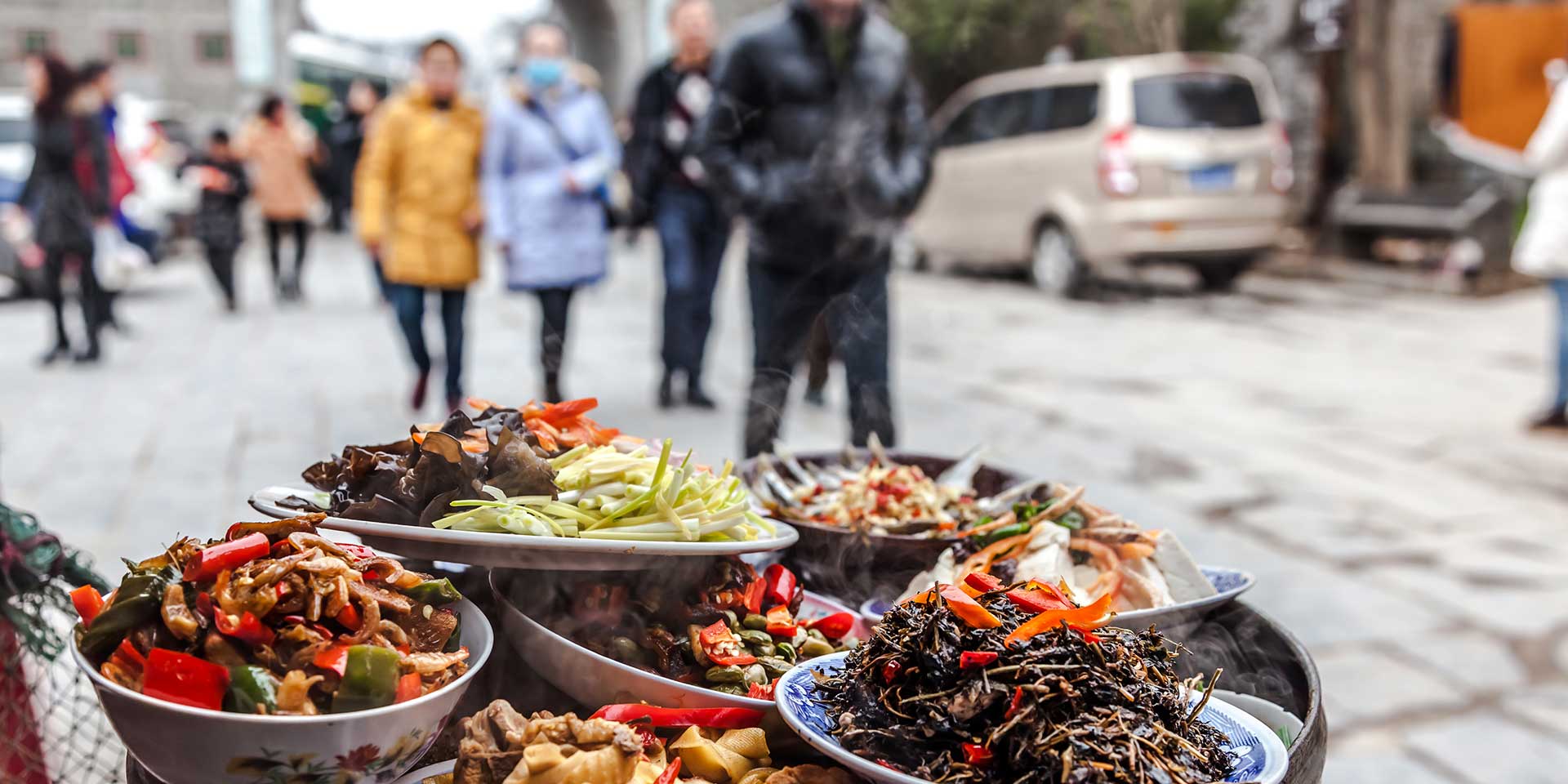Why Capers Are Culinary Game-Changers
Capers are the pickled, unopened flower buds of the Mediterranean caper bush that pack an incredible flavor punch despite their tiny size. These small, green orbs deliver a unique combination of salty, tangy, and lemony notes that can transform ordinary dishes into restaurant-quality meals.
Quick Capers Facts:
- What they are: Unripened flower buds from Capparis spinosa shrub
- Flavor: Briny, tangy, with hints of lemon and mustard
- Origin: Mediterranean basin and arid regions
- Processing: Hand-picked and preserved in salt or vinegar brine
- Nutrition: Only 2 calories per tablespoon, high in antioxidants
- Best uses: Sauces, salads, pasta dishes, and as garnishes
These tiny flavor bombs have been prized since ancient times – they even appear in the Epic of Gilgamesh from 2000 BC. Today, they remain a cornerstone of Mediterranean cuisine and are gaining popularity among home cooks who want to add authentic depth to their dishes.
The drought-tolerant caper bush thrives in harsh, rocky conditions where few other crops can grow, making them an environmentally smart choice. From classic chicken piccata to modern plant-based dishes, capers offer endless possibilities for elevating your cooking while being naturally vegan, gluten-free, and incredibly low in calories.

Key terms for capers:
Capers 101: Getting to Know the Tiny Flavor Bombs
Picture this: a thorny Mediterranean shrub clinging to rocky cliffs, producing tiny green buds that would become one of the world’s most prized flavor improvers. That’s the humble beginning of capers – those little green gems that have been changing dishes for over 4,000 years.
The story starts with Capparis spinosa, also known as the caper bush. This remarkable plant has been feeding civilizations since ancient times, with mentions appearing in the Epic of Gilgamesh around 2000 BC and even in Biblical texts. The Romans were absolutely obsessed with capers, using them not just to jazz up their food but also as medicine.
What’s fascinating is how these bitter, inedible flower buds transform into the tangy, salty delights we love. The magic happens through careful curing in salt or vinegar brine, which triggers chemical reactions that develop their signature flavor profile – that perfect blend of salty, tangy, and lemony notes with subtle umami hints.
What Are Capers?
Capers are simply unopened flower buds from the Capparis spinosa shrub, part of the Capparidaceae family. Think of them as flowers that never got their moment to shine – they’re harvested when they’re tight, dark green, and about the size of a small pea.
The caper bush itself is a true survivor. This sprawling perennial can grow up to 6 feet tall and spread 10 feet wide, with thick, waxy leaves that help it conserve precious water. Its extensive root system digs deep into rocky crevices, finding moisture where other plants would simply give up.
Where Do Capers Come From?
The natural home of capers stretches across the entire Mediterranean basin, from Spain’s sunny coasts to the rocky shores of Turkey and Iran. These plants absolutely thrive in harsh, arid climates where summer temperatures soar above 104°F and annual rainfall barely reaches 14 inches.
Spain leads production with about 6,400 acres, while Italy – especially the volcanic islands of Pantelleria and the Aeolian Islands – produces some of the world’s finest capers on roughly 2,500 acres. Morocco, Algeria, Turkey, and Greece round out the major producing regions.
Here’s what makes capers special: they’re still hand-harvested at dawn, just like they were thousands of years ago. Workers must pick the buds every 8-12 days throughout the growing season, requiring up to 12 separate harvests per season – which explains why quality capers cost what they do.
Capers vs. Caperberries
Capers and caperberries come from the exact same plant, but they’re completely different culinary experiences. Capers are the unopened buds, while caperberries are what happens when those buds are left to bloom, get pollinated, and develop into seeded fruit.
Caperberries are much larger – about an inch long compared to capers’ tiny 7-14mm size. They have a milder flavor than capers and make perfect cocktail garnishes or additions to antipasti boards. Price-wise, capers typically cost more, especially the smallest grades, because they require more precise timing and labor to harvest.
Caper Varieties, Sizes & Processing
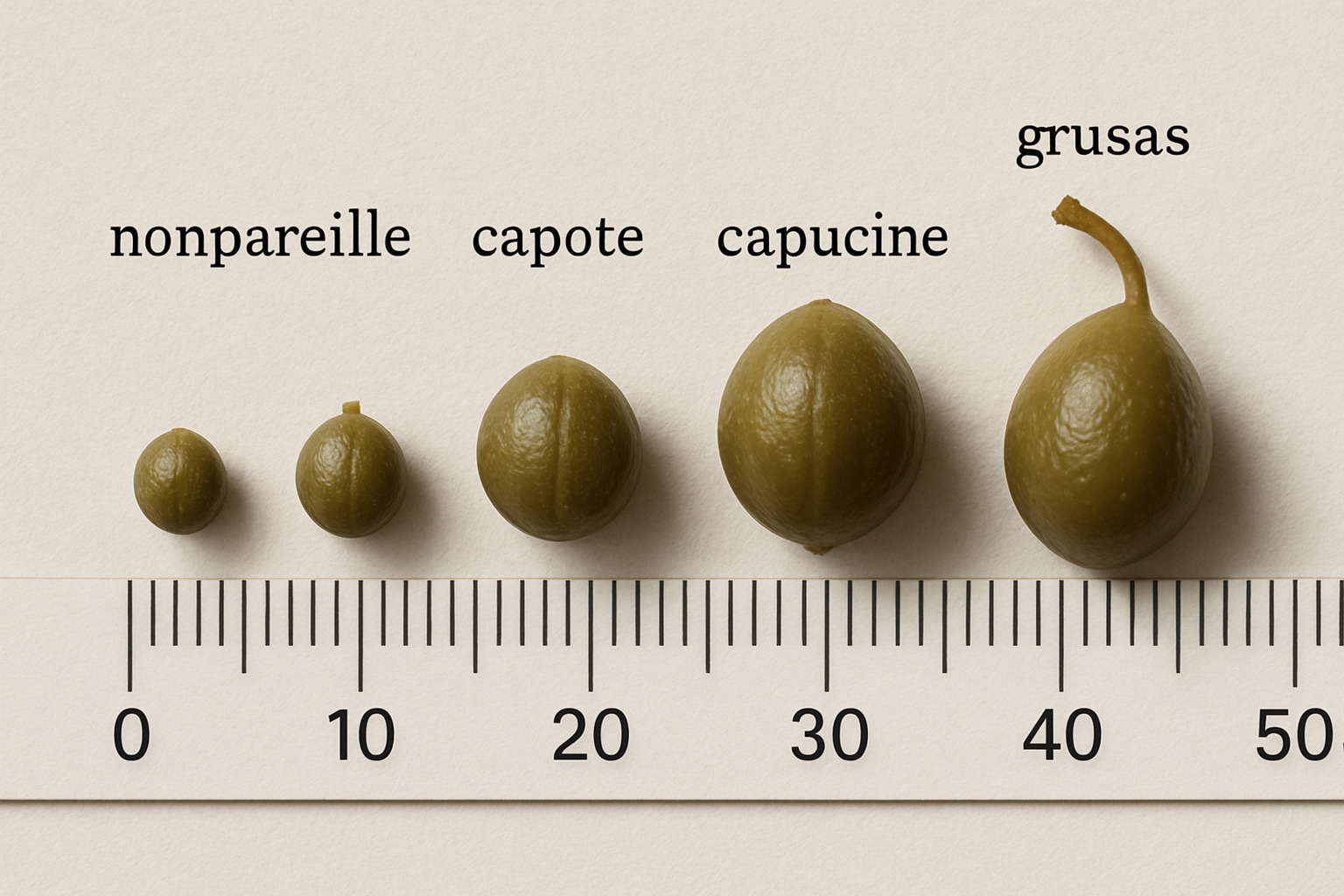
When you peek into capers, you’ll find there’s much more than meets the eye. Just like coffee beans or wine grapes, these tiny green gems are carefully sorted and graded. The size of your caper makes a real difference in both flavor and price.
Size Grades Explained (Why Nonpareils Cost More)
The caper world has its own sizing system. Capers are measured by their diameter in millimeters: nonpareils (under 7mm), surfines (7-8mm), capucines (8-9mm), capotes (9-11mm), fines (11-13mm), and grusas (14mm and up).
Smaller actually means better when it comes to capers. Those tiny nonpareils pack the most delicate flavor and have a tender texture that won’t overwhelm your dish. They require incredible precision during harvest – workers have to pick them at just the right moment when they’re perfectly sized.
Harvesting nonpareil capers is like plucking individual pearls from an oyster. The labor is intense, the timing is critical, and the yield is smaller. That’s why premium nonpareil capers can cost three times more than their larger cousins.
Harvesting & Curing Methods
The harvest of capers is one of those beautiful traditions that connects us directly to ancient times. Workers walk through Mediterranean hillsides at dawn, when the air is still cool and the tiny buds are firm and perfect. They visit each bush every single day during growing season, carefully selecting only the buds that have reached ideal size.
Once picked, the real magic begins through curing. Salt-packing is the old-school method where fresh buds get layered with coarse sea salt and left to cure for weeks. This ancient technique draws out moisture while concentrating flavors.
Vinegar brining is what most of us know from grocery store jars. The buds get packed in a tangy mixture of vinegar, water, and salt. During curing, enzymes break down compounds in the buds, creating that distinctive mustard-like bite. White spots on some capers are rutin crystals, a natural antioxidant that signals high quality.
Taste Profile of Capers
Capers deliver a surprisingly complex flavor experience. The first hit is usually salty and tangy, especially if they’re vinegar-brined. But then you’ll notice a bright, lemony quality that adds freshness to whatever you’re cooking.
What makes capers special is their ability to add umami – that savory depth that makes other flavors taste better. There’s also a subtle floral note hiding in there. The size dramatically affects their personality – precious nonpareils offer delicate, nuanced flavor, while larger capotes pack more punch for robust sauces.
Cooking with Capers: Techniques, Pairings & Recipes

There’s something magical about the way capers can transform a simple dish into something restaurant-worthy. These tiny flavor bombs work their magic by cutting through rich, fatty foods with their bright acidity and adding bursts of complexity that wake up your taste buds.
The secret to cooking with capers lies in timing and technique. Unlike ingredients that benefit from long, slow cooking, capers are delicate creatures that shine when added at just the right moment. Don’t throw away that caper brine – it makes incredible salad dressings and adds depth to marinades.
When planning your caper trips, consider exploring how Farm-to-Table Dining Experiences use these Mediterranean gems to highlight seasonal ingredients.
Classic Dishes Featuring Capers
Chicken Piccata is where many home cooks first fall in love with capers. The dish perfectly showcases how these little green orbs can transform a simple pan-seared chicken breast into something extraordinary. The capers provide textural pops and bright flavor bursts that cut through the rich butter and lemon sauce.
In Italy, Spaghetti alla Puttanesca combines pantry staples – tomatoes, olives, anchovies, and capers – into a dish that’s both bold and satisfying. The capers add essential brininess that balances the sweetness of tomatoes and the saltiness of anchovies.
The classic New York bagel experience wouldn’t be complete without capers scattered over lox and cream cheese. These tiny flavor bombs provide the perfect counterpoint to smoky salmon and rich cream cheese.
Preparation Tips for Maximum Flavor
Getting the most from your capers starts with proper preparation. Always rinse them under cold water before using – this removes excess salt and any cloudiness from the brine, letting their true flavor shine through.
For salt-packed capers, soaking is essential. Give them a cold water bath for a few hours, changing the water once or twice. Timing is everything when cooking with capers. Add them near the end of your cooking process to preserve their delightful texture and bright flavor.
Want to try something different? Frying drained capers in hot oil until they’re crispy creates amazing “caper chips” that make stunning garnishes for fish dishes or salads.
Substitutes & Flavor Hacks
Finely chopped green olives can step in beautifully, especially briny varieties like Castelvetrano. Pickled nasturtium seeds have been fooling people since the 1700s – they’re so close to capers in flavor that they earned the nickname “poor man’s capers.”
Pickled green peppercorns offer brininess with a spicy kick. For a simple hack, combine finely grated lemon zest with coarse salt to mimic some of that bright, salty punch that capers provide.
Nutrition & Health Benefits of Capers

Don’t let their tiny size fool you – capers are nutritional heavyweights that deliver impressive health benefits with almost zero calories. At just 2 calories per tablespoon, they’re one of the most efficient ways to add complex flavor to your meals without expanding your waistline.
The real magic happens when you look at their antioxidant content. Capers contain some of the highest levels of beneficial plant compounds found in any commonly used ingredient, which explains why Mediterranean cultures have valued them for both culinary and medicinal purposes for thousands of years.
Nutritional Snapshot
A single tablespoon of capers contains just 2 calories and is made up of 84% water. In that tiny tablespoon, you’ll get 21% of your daily vitamin K needs – essential for strong bones and proper blood clotting. You’ll also find meaningful amounts of vitamin A for eye health and iron to support healthy blood.
The standout nutritional feature of capers is their incredible quercetin content – at 173 mg per 100g, they’re one of the richest dietary sources of this powerful flavonoid. They also contain high levels of kaempferol (131 mg per 100g), another beneficial plant compound.
There’s one important number to keep in mind: 480 mg of sodium per tablespoon. That’s about 20% of your daily sodium needs.
Potential Benefits & Concerns
The research on capers and health is genuinely exciting. Their high quercetin content acts as a natural anti-inflammatory agent throughout your body. Some studies suggest this could support heart health and help reduce the risk of chronic diseases.
There’s also promising research about blood sugar support. Compounds in capers may help regulate blood sugar levels, which could be beneficial for people managing diabetes. Some studies suggest that compounds in capers might help reduce the formation of potentially harmful compounds when you’re enjoying grilled foods.
The main concern is sodium content. Capers are extremely high in sodium – that single tablespoon contains about 20% of what most people should have in an entire day. If you have high blood pressure, you’ll want to rinse your capers thoroughly and use them sparingly.
You can learn more about the scientific research through detailed studies on their health benefits.
Suitability for Special Diets
Capers are wonderfully inclusive when it comes to dietary restrictions. They’re naturally vegan and vegetarian, completely gluten-free, and perfect for ketogenic diets with less than 1 gram of net carbs per tablespoon. They also fit perfectly into paleo eating plans as a naturally preserved, traditional food.
The main consideration is for people on low-sodium diets. While the health benefits are real, the high sodium content means they should be used thoughtfully if you’re managing blood pressure.
Buying, Storing & Sustainability Practices
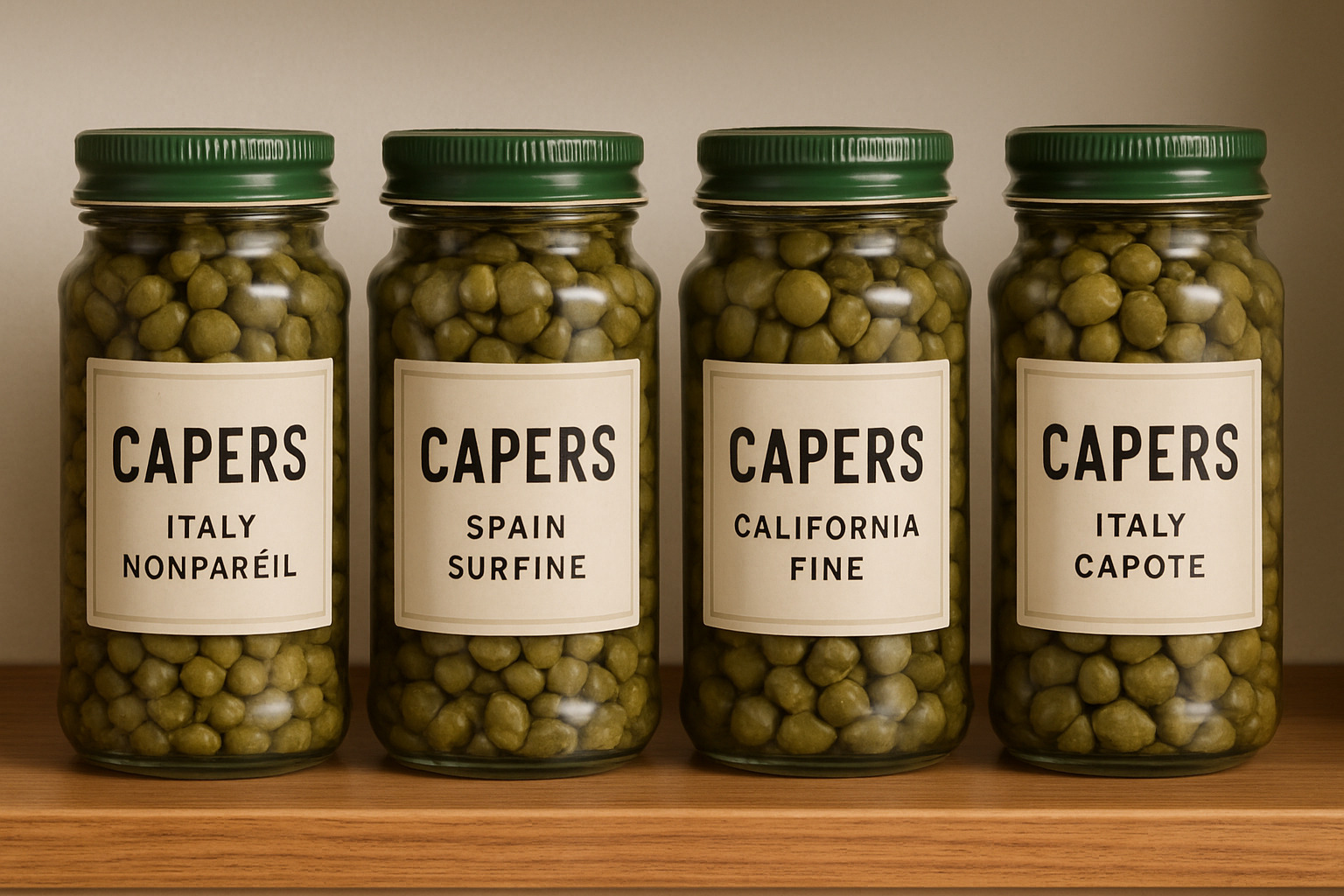
Walking down the condiment aisle can feel overwhelming when you’re faced with dozens of capers options. The truth is, not all capers are created equal, and knowing what to look for can make the difference between a good dish and a great one.
How to Choose Quality Capers
The secret to finding exceptional capers starts with reading the label carefully. Nonpareil capers should be your first choice if budget allows – these tiny powerhouses offer the most refined flavor and delicate texture. If the jar doesn’t specify the size grade, you’re probably looking at larger, less expensive varieties.
Color tells you everything about freshness. Premium capers display a vibrant dark green that practically glows through the glass. Avoid any that look brownish, yellowed, or patchy.
European capers from traditional growing regions like Pantelleria carry premium price tags for good reason. Look for PGI (Protected Geographical Indication) or PDO (Protected Designation of Origin) labels – these certifications guarantee authentic production methods.
The brine should be crystal clear, not cloudy or murky. Through the glass jar, the capers themselves should look plump and intact, not shriveled or broken apart.
Storing Capers the Right Way
Proper storage keeps your capers at peak performance long after opening. Unopened jars happily sit in your pantry for up to two years, but once you break that seal, they need refrigeration.
The golden rule with opened capers is keeping them completely submerged in their brine. Properly stored this way, your capers will maintain their punch for 9-12 months in the fridge.
Salt-packed capers can stay at room temperature for months in their original container, but once opened, treat them like any perishable and move them to the refrigerator.
Here’s a pro tip: freeze caper brine in ice cube trays. The high salt content creates perfect slushy cubes that add instant complexity to cocktails and Bloody Marys.
Sustainable & Ethical Sourcing
Capers represent one of agriculture’s most environmentally friendly success stories. These remarkable plants thrive in harsh, rocky terrain where virtually nothing else will grow, turning wasteland into productive farmland without demanding precious water resources.
The drought-tolerant caper bush needs no pesticides and minimal irrigation, making it a champion of sustainable farming. The hand-harvesting tradition creates employment in rural Mediterranean communities that might otherwise struggle economically.
For those passionate about making environmentally conscious food choices, understanding Locally Sourced Ingredients provides valuable context for building a more sustainable kitchen overall.
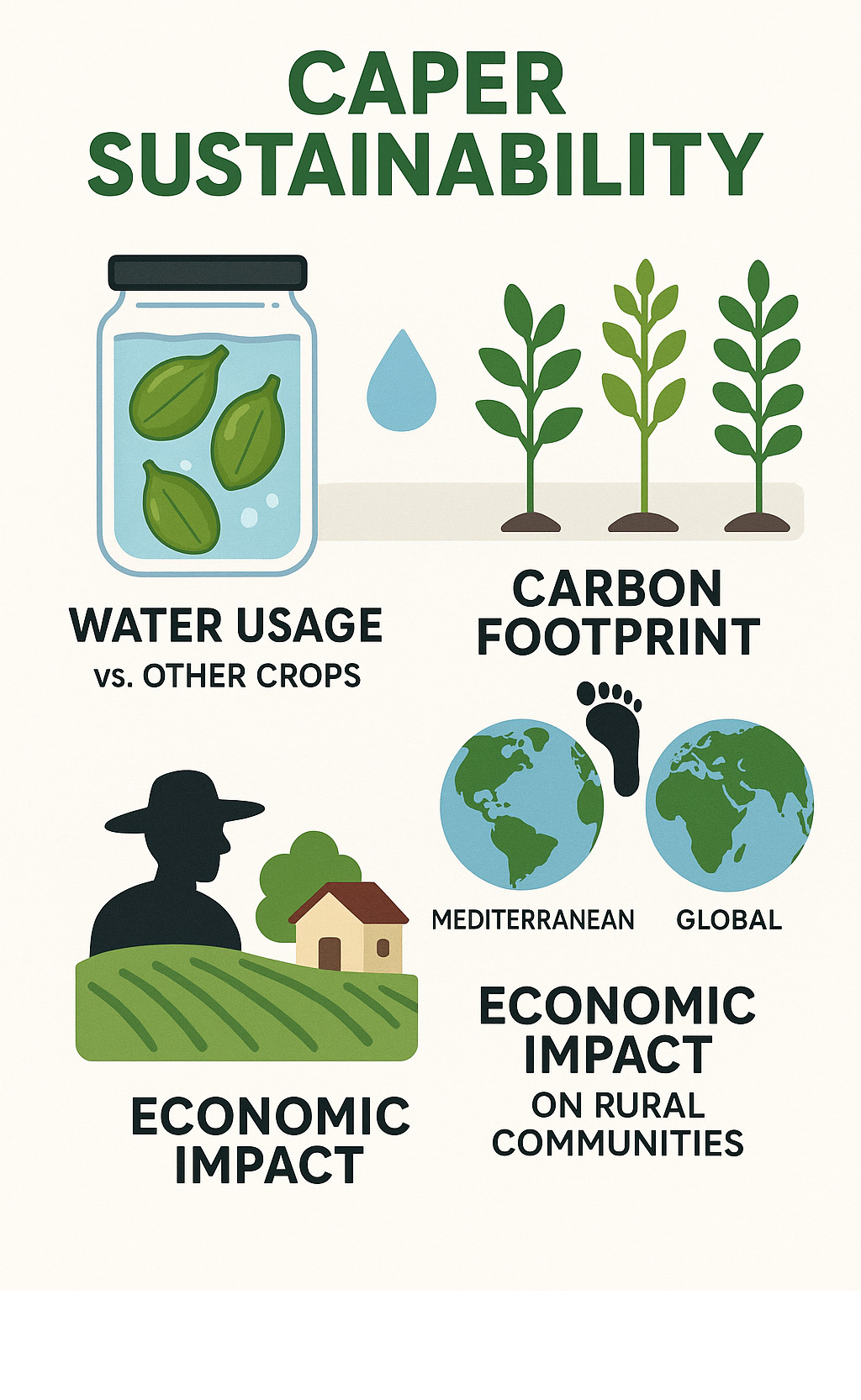
Frequently Asked Questions about Capers
Are capers fruits, vegetables, or herbs?
This is one of the most common questions about capers, and the answer might surprise you. They’re technically none of these traditional categories! Capers are unopened flower buds, which puts them in a unique botanical category.
Think of them like broccoli or artichokes – we’re eating the flower parts of the plant before they have a chance to bloom. If you left capers on the bush instead of harvesting them, they would eventually open into beautiful white flowers and then develop into caper berries (which are the actual fruits).
So while capers aren’t exactly vegetables in the strictest sense, that’s the closest category they fit into. They’re immature reproductive structures of the Capparis spinosa plant – basically flowers that never got their moment to shine.
Can I eat capers straight from the jar?
Absolutely! Many people enjoy capers straight from the jar, though we definitely recommend giving them a quick rinse first. The curing process makes them quite salty and flavored, so they pack a serious punch when eaten alone.
Think of them like olives – some people love snacking on them directly, while others prefer them as part of a larger dish. They make fantastic additions to cheese boards or antipasti platters when served straight. Just remember that their bold, briny flavor means a little goes a long way.
If you’re new to capers, try starting with just a few to get used to their unique taste. Once you develop a taste for them, you might find yourself reaching for the jar more often than you’d expect!
How long do capers last once opened?
Capers have impressive staying power thanks to their high salt content, which acts as a natural preservative. Once opened, jarred capers can last 9-12 months in the refrigerator when stored properly.
The secret is keeping them completely submerged in their brine and stored in an airtight container. Never let them sit exposed to air, as this can lead to spoilage and loss of flavor.
Salt-packed capers are even more forgiving – they can last up to 6 months at room temperature in their original container. Once you open salt-packed varieties, it’s best to transfer them to an airtight container and refrigerate them.
You’ll know your capers have gone bad if they develop off odors, show any signs of mold, or if the brine becomes very cloudy and murky. Properly stored capers should maintain their firm texture and bright green color throughout their shelf life.
Conclusion
Capers truly are one of the culinary world’s most underappreciated ingredients. These tiny flavor bombs can transform simple ingredients into sophisticated dishes while adding minimal calories and maximum taste impact. From their ancient origins in Mediterranean cuisine to their modern applications, capers continue to prove their versatility and value.
The beauty of capers lies in their ability to lift any dish without overwhelming it. Whether you’re making a classic chicken piccata or experimenting with modern vegan creations, these little green gems provide that perfect burst of briny, tangy flavor that makes everything taste more restaurant-quality.
When selecting capers, quality truly matters. Choose smaller nonpareil varieties when your budget allows, look for clear origin labeling from traditional Mediterranean producers, and consider the sustainability story behind your purchase. These drought-tolerant plants represent one of agriculture’s most environmentally friendly crops.
Don’t overlook the liquid gold sitting in your caper jar – that caper brine works beautifully whisked into salad dressings, used to deglaze pans for quick pan sauces, or even added to cocktails for an unexpected twist.
Proper storage will keep your capers tasting fresh for months. Just remember to keep them submerged in their brine and refrigerated after opening.
As more home cooks find the magic of these tiny Mediterranean treasures, capers are experiencing a well-deserved renaissance. They represent the perfect intersection of tradition, intense flavor, and environmental responsibility – exactly what today’s conscious food lovers are seeking.
For more insights into how sustainable ingredients like capers are shaping modern dining, explore Food Sustainability Trends.
From our team at The Dining Destination in New York City, we hope this guide inspires you to accept these remarkable little buds in your own culinary trips. Whether you’re preparing a weeknight dinner or hosting a dinner party, capers offer endless possibilities for elevating your cooking to new heights.

